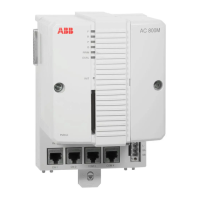Fibre Optic Transmission Technology Section 2 Transmission Technology
42 3BDS009029R5001 B
Fibre Optic Transmission Technology
Fibre-optic transmission is suitable for use in areas with high electromagnetic
interference or where greater network distances are required. The PROFIBUS
guideline (2.022) for fibre optic transmission specifies the technology available for
this purposes. When determining these specifications, great care was naturally taken
to allow problem-free integration of existing PROFIBUS devices in a fibre optic
network without the need to change the protocol behavior of PROFIBUS.
All familiar network structures such as point-to-point connections, line and star
structures as well as single-fiber ring or double-fiber ring can be set up with
PROFIBUS. Mixed structures combining electrical and optical networks are
possible. The transition between the two media is provided by an optical link
module, which convert the RS485 to fibre optic transmission technology. In the
communication between the stations on the bus, there is no difference between two-
wire and fiber-optic technology.
Optical link modules mostly supports all the transmission rates defined in the EN
50170 standard.
Fibre optics cable type and speed
Fibre optics is an additional transmission technology for PROFIBUS DP. It uses a
glass or plastic fibre cable and enables transmission rates in steps from 9.6 kbit/s to
12 Mbit/s, depending on the hardware. Fibre optic networks are mostly used in
connection with RS485 to increase network distances of PROFIBUS DP, to avoid
communication errors in areas with high electromagnetic interference or just to
ensure galvanic insulation between different hardware units (master, slaves)
connected to an RS485 networks. The fibre optic transmission technology is usually
limited to a specific segment of a plant, which is then connected to the RS485 bus
line via RS485/fibre optic converter.

